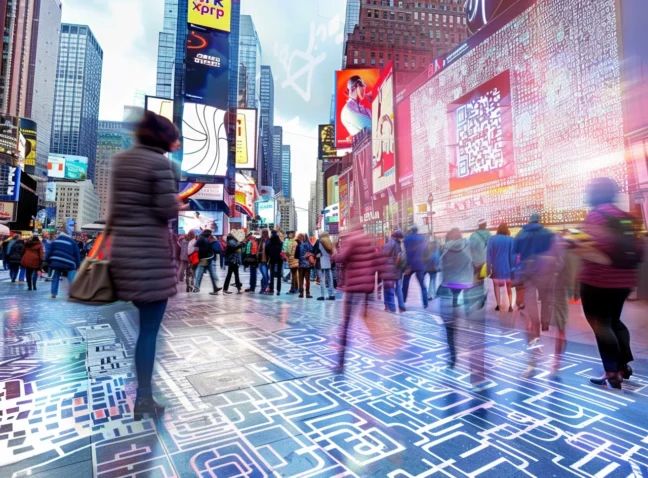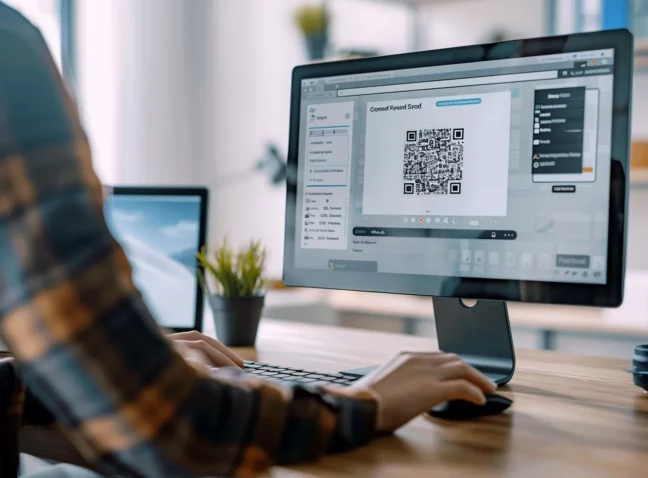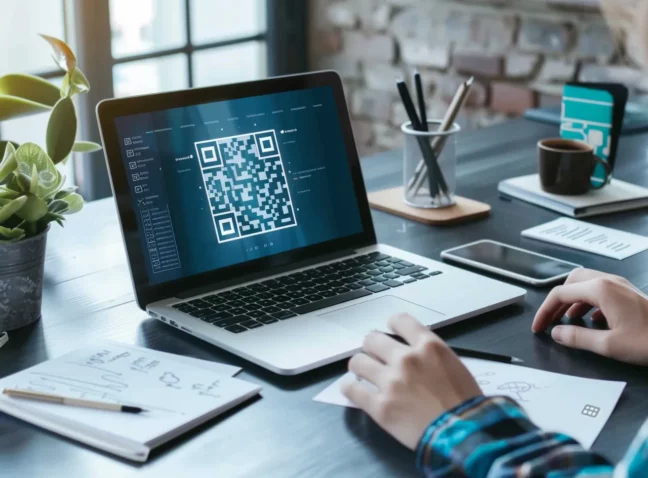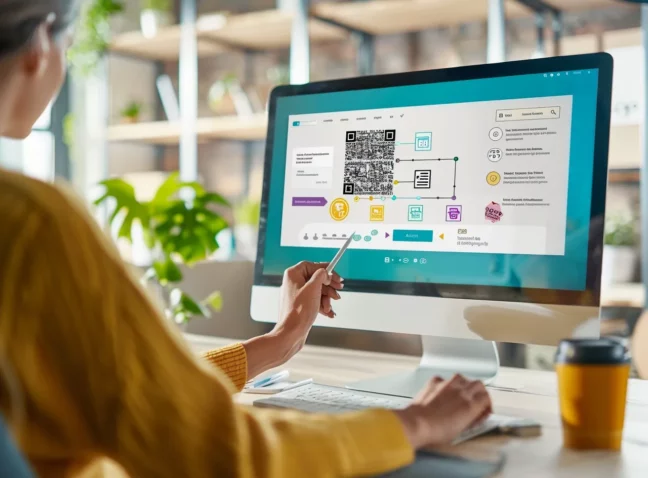URLs and QR codes. A perfect pairing and a popular one at that. Especially when you consider that 47.68% of all QR codes are paired with URLs. Despite their popularity within QR codes, however, there’s a few factors that many overlook when linking URLs with QR codes that can affect their scannability and even user engagement numbers; URL standards.
If you’re wondering: ‘What on Earth are URL standards and what have they got to do with QR codes?’, we’ve got you covered. We here at MyQRCode are all about educating users on the proper utility of QR codes, and how to get the most out of them. And today, we’ll be going over URL standards and optimization. So, let’s get started!

QR Codes & URL Mastery: Skyrocket Digital Presence
If you’re familiar with the realms of SEO (particularly the technical side), you’ll no doubt be familiar with URL standards and optimization. But for the uninitiated, URL standards basically means that your URLs are structured and formatted properly, and encoded properly. URL optimization on the other hand, basically means streamlining your URL into simple understandable terms. For instance, consider the following URL:
https://www.kazumakiryu.com/index.php?id_sezione=360&sid=3a5ebc944f41daa6f849f730f1
Looks pretty terrible, right? It’s undecipherable for human eyes, and can even be a struggle for web crawlers to understand. But, when properly optimized, it’ll look something like this:
https://www.kazumakiryu.com/kamurocho/tojoclan
Beautiful. Everything is sequenced properly. You’ve got the website, index page, and subsection, all lined up chronologically. The thing is, URL optimization isn’t just good for humans and web bots, either. It’s good for QR codes, too, as smartphone cameras have a much easier time scanning QR codes linked with simple URLs. That’s because the URL can be the changing factor of whether you’ve got a mess of black-on-white, or a well-structured QR code. Here’s how you can ensure that your QR codes are paired with a good URL:
- Use simple, yet descriptive words in your URLs for better understandability.
- Ensure UTF-8 encoding for non-ASCII characters to cater to a global audience.
- Implement country-specific domains and subdirectories for localized relevance.
- Regularly review and update your URLs to maintain SEO health.
- Seamlessly integrate QR codes with optimized URLs for immediate user engagement.
In that list, you may have been confused by terms like UTF-8 and non-ASCII. ASCII essentially describes characters that can be read by web crawlers, while non-ASCII describes all other characters outside that range. This mostly pertains to special characters within a language. Think Cyrillic, Kanji, and Arabic characters. Unfortunately, these characters can’t be read by web crawlers, so they need to be presented as percentage values using the UTF-8 encoding practices. For instance, below is how an Arabic URL would be encoded using UTF-8:
https://www.example.com/%D9%86%D8%B9%D9%86%D8%A7%D8%B9/%D8%A8%D9%82%D8%A7%D9%84%D8%A9
Now that we’ve got all that jargon out of the way, it’s time to delve into the wonderful world of QR codes and URLs in a little more detail.
QR Codes & URLs: Master Keys to Digital Success
One thing to keep in mind is that clean URLs aren’t just good for your QR codes. They’re a cornerstone to a successful SEO strategy, too. Complex URLs aren’t just painful for human eyes; they can be difficult for web crawlers to read as well, which might lead to certain web pages not being indexed, which means that they won’t appear on Search Engine Results Pages (SERPs) when a user searches for a particular query. Not only that, but complicated URLs can also lead to mistakes within the URLs themselves, which could lead to a broken link.
You might be wondering how that affects QR codes. Well, a QR code containing a broken link will never work, because the URL doesn’t actually lead to the proper page. Additionally, if your pages aren’t getting indexed, users might not view the QR code as trustworthy, especially if they can’t find any additional pages from your site on Search Engines. So, to avoid this, you should:
- Keep URLs Short and Sweet: Aim for concise, memorable URLs. Shorter URLs are not only easier for users to remember and type, but they also fit better on marketing materials, including the limited space of a QR code. This simplification aids in improving user experience and search engine optimization by making links more straightforward for algorithms to process and index.
- Use Static URLs Where Possible: Opt for static URLs whenever feasible, as they are inherently more SEO-friendly and user-friendly than their dynamic counterparts. Static URLs remain constant for each page, making them easier for search engines to index and for users to understand and recall. This stability is particularly beneficial when linking from QR codes, as it ensures a consistent destination for users over time.
By focusing on these foundational aspects, you’re not just improving your site’s navigability and search engine ranking; you’re also creating a more cohesive and engaging digital experience for users, whether they’re accessing your content through a traditional URL or the modern convenience of a QR code.

QR Magic: Elevating Your Online Presence
As a platform that generates QR codes, we’d be remiss if we didn’t provide some of the common benefits associated with QR codes containing URLs. Considering that QR code use has become even more popular in recent years, especially when you consider that in 2024, we’ve already reached combined worldwide scan rates of 26.95 million. As a business, you almost need QR codes to compete in the modern world, and here’s why:
- Immediate Website Access: Imagine transforming a casual glance at a poster into a deep dive into your online universe. QR codes do exactly that by embedding optimized URLs that whisk users away to your website, bypassing the need for cumbersome typing. This direct route is not just about saving time; it’s about creating a fluid, frictionless path that guides users exactly where you want them—the heart of your digital domain.
- Offline to Online Bridge: Take your physical marketing materials—flyers, posters, business cards—and infuse them with the power of digital interactivity. A QR code placed strategically on these materials can serve as a portal, inviting consumers to step from the tangible world into your online space. It’s an invitation to explore, to learn more, and to connect on a deeper level, turning passive observers into active participants in your brand’s story.
- Boosted User Engagement: Through the simple act of scanning a QR code, customers are granted access to a world of information—product details, testimonials, instructional videos, or exclusive promotions. This immediate access does not just inform; it enhances the user experience by providing value that is tailored and immediate, deepening the customer’s connection to your brand and increasing the likelihood of conversion.
- Insightful Data Collection: With each scan, QR codes offer a glimpse into the customer’s journey, capturing valuable data on their preferences, behaviors, and interaction patterns. This information is a treasure trove for marketers, offering insights that can shape future strategies, refine targeting, and create more personalized, impactful campaigns. By understanding how and when consumers engage, you’re equipped to craft messages that resonate and experiences that delight.
By integrating QR codes into your marketing strategy, you’re not just keeping pace with the digital evolution; you’re positioning your brand as a leader in the integration of physical and digital experiences. Let’s delve deeper into the transformative power of QR codes and how they can amplify your online presence.
Boost Your Brand with Smart URL & QR Code Strategies
One thing that many businesses seem to forget is the fact that QR codes and URLs can be extensions of your brand identity. This is especially true of QR codes, where it can be a consumer’s first point of contact with your brand’s digital presence. So, making a good first impression can be paramount to your business’s success. Here’s a few things to keep in mind when implementing your QR codes:
- Customize QR codes to reflect your brand’s aesthetic, making every scan a branded experience.
- Track QR code scans to glean insights into customer engagement and campaign effectiveness.
- Use dynamic QR codes for flexibility, allowing you to update linked information without changing the code itself.
- Integrate QR codes in marketing materials to effortlessly guide your audience to your digital doorstep.
- Leverage QR codes for exclusive content, providing a unique value that incentivizes users to engage.
Embarking on this journey promises to not only fortify your SEO efforts but also to unlock a realm where every click and scan deepens the connection with your audience. Discover how this synergy between smart URLs and QR codes can turn your digital platform into a beacon of user engagement and loyalty.

Elevate Engagement: Smart URLs & QR Code Magic
Integrating QR codes with URLs are a portal for increased customer engagement, especially when it comes to your digital content and websites. As long as you’re smart with their implementation, your business should see good returns. And we’ve got the numbers to prove it.
In a nutshell, the magic of QR codes and smart URLs lies in their ability to:
- Increase Interaction Rates: Studies show that campaigns utilizing QR codes see a 25-30% higher interaction rate compared to those without.
- Boost Mobile Engagement: With over 85% of the population using smartphones, QR codes offer an immediate bridge to digital content, significantly enhancing mobile engagement.
- Level-up Conversions: Businesses report up to a 50% increase in conversion rates when QR codes are used to streamline the user journey from physical to digital touchpoints.
- Enhance User Retention: Personalized landing pages accessed via QR codes contribute to a 70% increase in user retention rates, as they provide tailored experiences.
- Advance Accessibility: QR codes have made digital content 40% more accessible to users who find navigating complex websites challenging, thereby broadening the audience base.
These points underscore the transformative impact of integrating QR codes and smart URLs into digital engagement strategies.
Leverage QR Code Creators: Amplify Reach & User Experience
As should be demonstrably clear in this article, URL standards are important when it comes to successful QR code implementation. By following URL standards, and ensuring they’re compliant with encoding practices, your QR codes will see a boost in scannability, engagement, and will look prettier in the meantime. And that can bring about huge advantages for your business.
And if you’re looking to generate your own QR codes, why not give MyQRCode’s Link QR Code Generator a try? Not only can you generate a QR code in a matter of minutes, you’ll have full control over a number of design aspects of the QR code itself, tweaking the color, changing the QR pattern, and even being able to add your company logo for a fully branded experience. So what are you waiting for? Generate your QR code today!





